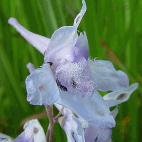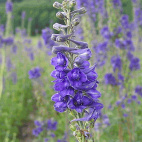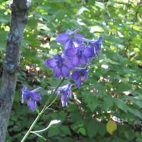Western Larkspur Seeds
- HOW TO GROW
- FAST FACTS
- REVIEWS
HOW TO GROW
Sowing: Direct sow in late fall, planting just below the surface of rich soil. To plant in the spring, mix the seed with moist sand and store it in the refrigerator for 60 days before direct sowing. This seed can also be planted indoors on the surface of a flat, and kept evenly moist and at a temperature of 60-65 degrees F until germination. Transplant seedlings after the last chance of frost.
Growing: Water the plants occasionally, especially in periods of dry weather. Avoid overwatering, since good drainage produces the healthiest growth. Keep weeds down, since this plant does not like competition. Remove wilted blossoms for the best blooming; if blooming decreases, the entire plant can be cut back for new growth and possible second blooming. If the flowers are left to mature, they will readily reseed. This plant attracts hummingbirds and butterflies and resists deer.
Harvesting: For fresh flowers, cut the stems near the ground and place them in water immediately; strip the leaves that will fall below the water. Handle these plants with care, since the seeds and leaves contain poison.
Seed Saving: After the flowers fade, this plant will produce papery light brown seed pods that open at the top when ripe. Mature seed will be a dark brown color. Remove entire stalks of ripe seed pods and spread them out to dry. Alternatively, the plants can be shaken over a container to remove the seed from the open pods. Store the cleaned seed in a cool, dry place.
FAST FACTS
Common Names: Tall Mountain Larkspur, Duncecap Larkspur, Subalpine Larkspur
Latin Name: Delphinium occidentale
Species Origin: US Native Wildflower
Type: Native Wildflowers
Life Cycle: Perennial
USDA Zones: 3, 4, 5, 6, 7, 8
US Regions: Mountain, Arid/Desert, Plains/Texas
Seeds per Ounce: 8,600
Stratification: Cold/Wet for 8 Weeks
Germination Ease: Stratify 8 Weeks
Sunlight: Full Sun, Part Sun
Height: 48 Inches
Color: Blue, Purple
Bloom Season: Blooms Late Summer
Uses: Hummingbirds, Cut Flowers
Thoughtful company
Hard to find native seeds packaged with extras to insure success
DESCRIPTION
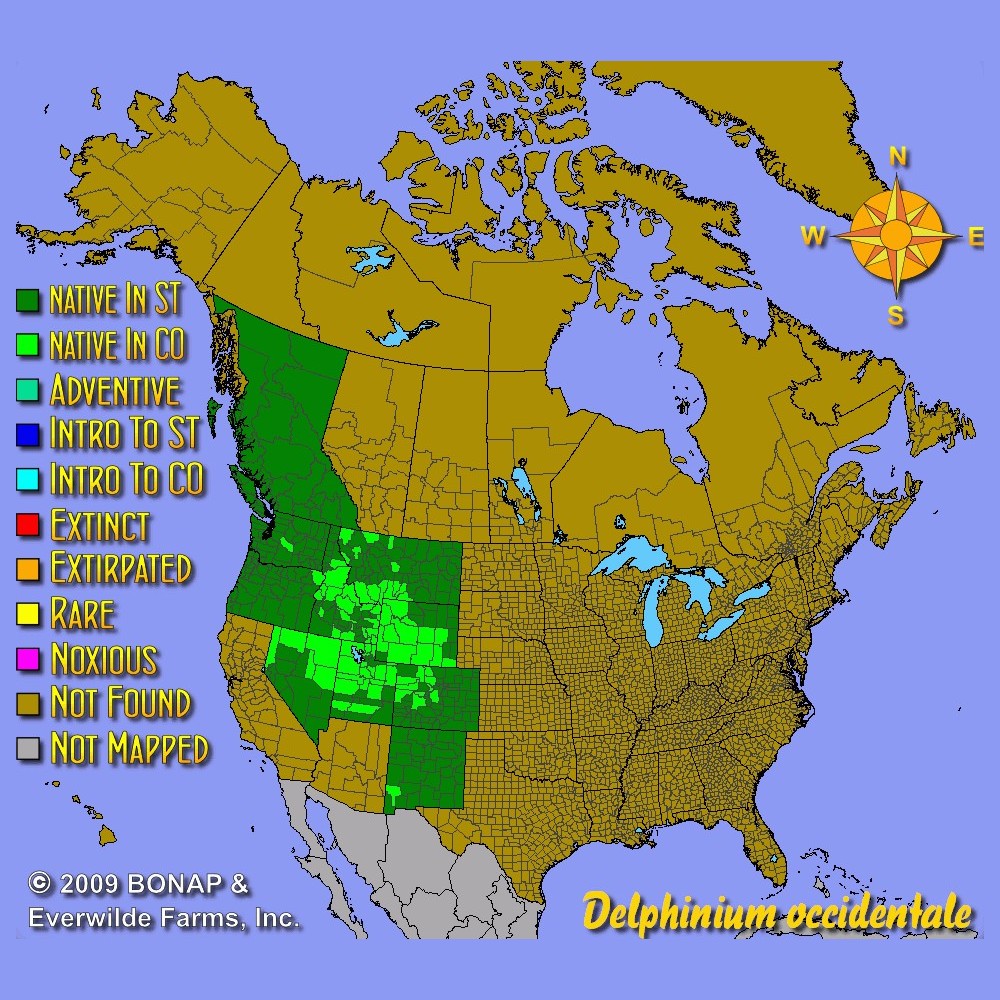
HOW TO GROW
Sowing: Direct sow in late fall, planting just below the surface of rich soil. To plant in the spring, mix the seed with moist sand and store it in the refrigerator for 60 days before direct sowing. This seed can also be planted indoors on the surface of a flat, and kept evenly moist and at a temperature of 60-65 degrees F until germination. Transplant seedlings after the last chance of frost.
Growing: Water the plants occasionally, especially in periods of dry weather. Avoid overwatering, since good drainage produces the healthiest growth. Keep weeds down, since this plant does not like competition. Remove wilted blossoms for the best blooming; if blooming decreases, the entire plant can be cut back for new growth and possible second blooming. If the flowers are left to mature, they will readily reseed. This plant attracts hummingbirds and butterflies and resists deer.
Harvesting: For fresh flowers, cut the stems near the ground and place them in water immediately; strip the leaves that will fall below the water. Handle these plants with care, since the seeds and leaves contain poison.
Seed Saving: After the flowers fade, this plant will produce papery light brown seed pods that open at the top when ripe. Mature seed will be a dark brown color. Remove entire stalks of ripe seed pods and spread them out to dry. Alternatively, the plants can be shaken over a container to remove the seed from the open pods. Store the cleaned seed in a cool, dry place.
FAST FACTS
Common Names: Tall Mountain Larkspur, Duncecap Larkspur, Subalpine Larkspur
Latin Name: Delphinium occidentale
Species Origin: US Native Wildflower
Type: Native Wildflowers
Life Cycle: Perennial
USDA Zones: 3, 4, 5, 6, 7, 8
US Regions: Mountain, Arid/Desert, Plains/Texas
Seeds per Ounce: 8,600
Stratification: Cold/Wet for 8 Weeks
Germination Ease: Stratify 8 Weeks
Sunlight: Full Sun, Part Sun
Height: 48 Inches
Color: Blue, Purple
Bloom Season: Blooms Late Summer
Uses: Hummingbirds, Cut Flowers
Reviews
Review
Thoughtful company
Hard to find native seeds packaged with extras to insure success
Also Consider These:
-
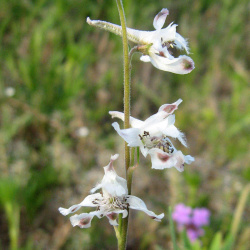 Out Of Stock
Wild Blue Larkspur Seeds
Delphinium carolinianum
Ranging from purple to blue in color, this elegant wildflower brings class wherever it grows. This native cousin of the delphinium is sometimes found growing in grasslands and prairies.Quick Viewx
Out Of Stock
Wild Blue Larkspur Seeds
Delphinium carolinianum
Ranging from purple to blue in color, this elegant wildflower brings class wherever it grows. This native cousin of the delphinium is sometimes found growing in grasslands and prairies.Quick ViewxWild Blue Larkspur Seeds
Delphinium carolinianum
Ranging from purple to blue in color, this elegant wildflower brings class wherever it grows. This native cousin of the delphinium is sometimes found growing in grasslands and prairies.
$3.96 Pkt - $220.00 / Oz -
 Tall Larkspur Seeds
Delphinium exaltatum
The deep purple spires of this tall perennial will attract hummingbirds to your garden! This rather unusual native is a cousin of the domesticated delphinium and is often found growing in the wild in open woodland areas.Quick View$3.75 Pkt - $80.00 / Oz
Tall Larkspur Seeds
Delphinium exaltatum
The deep purple spires of this tall perennial will attract hummingbirds to your garden! This rather unusual native is a cousin of the domesticated delphinium and is often found growing in the wild in open woodland areas.Quick View$3.75 Pkt - $80.00 / Oz -
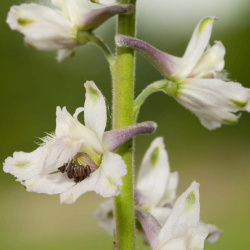 Out Of Stock
Prairie Larkspur Seeds
Delphinium virescens
Pretty spikes of whitish blossoms adorn this uncommon wildflower. This perennial cousin of the annual delphinium typically grows in drylands of the American Plains but is content to be grown in average garden soil too.Quick Viewx
Out Of Stock
Prairie Larkspur Seeds
Delphinium virescens
Pretty spikes of whitish blossoms adorn this uncommon wildflower. This perennial cousin of the annual delphinium typically grows in drylands of the American Plains but is content to be grown in average garden soil too.Quick ViewxPrairie Larkspur Seeds
Delphinium virescens
Pretty spikes of whitish blossoms adorn this uncommon wildflower. This perennial cousin of the annual delphinium typically grows in drylands of the American Plains but is content to be grown in average garden soil too.
$3.96 Pkt - $60.00 / Oz





